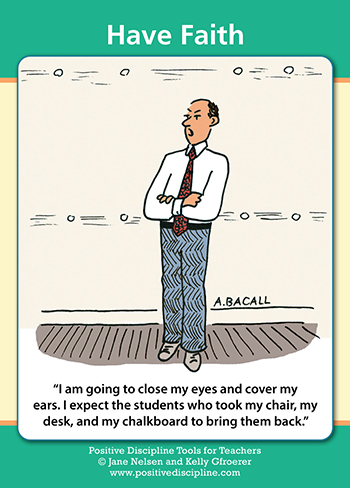by Dr. Jane Nelsen and Dr. Kelly Gfroerer, from their book Positive Discipline Tools for Teachers.

You can offer support that invites them to think by validating feelings. You can also offer some guidance through curiosity questions (see the Curiosity Questions: Motivational and Curiosity Questions: Conversational tools). You show faith by not rescuing, fixing, or controlling, and instead get students involved in helping and problem-solving.
Patience is probably the most difficult part of showing faith in your students. It almost always seems more expedient to solve problems for students. This is particularly true if you believe teaching means students should be passive receptors of your knowledge, or if you attempt to settle conflicts through punishments or rewards.
Dreikurs pointed out that students would know if you genuinely have faith in them and their ability to strive and move forward. Allow them to feel a little disappointment. Allow them to work through their feelings. Allow them to problem-solve on their own. They will need these skills in the future. Encouraging yourself and your students requires a lot of faith—faith in yourself, faith in your students, and faith in the Positive Discipline tools to produce the results you hope for. As you read the following “Tool in Action” story, notice the teacher’s kindness, her firmness, and the faith she has in herself, her student, and the tools being used.
Tool in Action
Every Friday we have a vocabulary quiz in my tenth-grade English class. Last week was unusually busy, and we didn’t have a lot of class time to study the words that appeared on Friday’s quiz. Typically, when I give a quiz or test, I proctor the exam from the front of the classroom.
This past Friday, Jordan was obviously looking at his neighbor’s quiz. I whispered in his ear, “How else do you think you might accomplish a good grade?” He immediately apologized.
After class, all the students had exited, but Jordan stayed behind. He was horrified at what he had done. He said, “Ms. Loiewski, I am terribly sorry. I only looked at one answer, and I promise I didn’t look at any others.” “Okay, what is your plan for next week?”
“I promise I will study more, and I will even help other students study.” For the next vocabulary quiz, Jordan was highly motivated to perform better. In our homework basket, he placed a paper with all of the words written out with definitions and sentences. When I asked him about all this extra work, he responded that he had fun studying and really wanted to earn 100 percent.
—Diana Loiewski, high school teacher, Certified Positive Discipline Educator
TOOL TIPS
- Express faith: “I have faith that you two can figure out a solution that works for both of you.”
- Avoid rescuing: “Do the best you can, and then I’ll help.” When you know students are capable, rescuing communicates that you think they are not.
- Offer a choice: “Do you want help from the whole class during a class meeting, or to use the Wheel of Choice?”
- Use encouragement to show faith in a student’s ability: “I notice you are sticking with that problem, even though it is hard for you.”
- Have faith in students to use their power for heartwarming social interest when given the opportunity.


